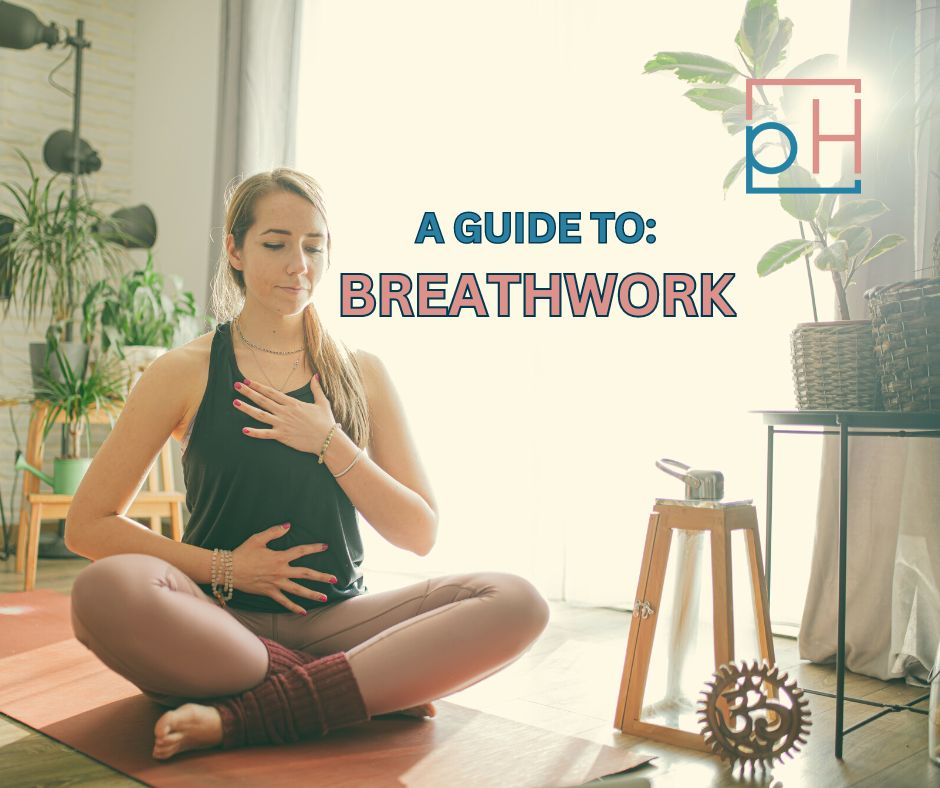Most of the day, we humans don’t consciously think about breathing. Our lungs are on autopilot, and it isn’t until there is a problem that we think about the breaths we are taking.
Consciously controlling, manipulating, and practicing the breaths we take is called breathwork. Breathwork can have tremendous effects on our mental health and our bodies.
At PrimeHealth, we believe the body is a network of interdependent systems, and starting a breathwork practice is a great way to be proactive about the connection between these systems.
This guide will help you understand forms of breathwork and get you started with your own breathwork sessions.
What Is Breathwork?
Breathwork uses breathing exercises and techniques to control stress responses, improve physical health, and boost mental well-being.
By having conscious control over your breathing patterns, you can influence your mind-body connection and experience many positive changes in your health.
The yogic breathing practice of pranayama was first documented in early Hindu texts dating back to the first millennium BCE. Today, there are many types of breathwork, each having subtly different benefits and methods of practice.
Breathwork is now considered a valuable tool in healthcare settings for managing conditions like high blood pressure and post-traumatic stress disorder. For many of my patients, breathwork serves as a bridge to heightened self-awareness and profound insights.
Related: The Gut-Brain Connection: How Your Gut Impacts Your Mental Health
Benefits of Breathwork
Breathwork is more than intentionally taking in air. It has notable, scientifically documented benefits. Learning to harness breath control can help with health conditions such as PTSD, cardiovascular disease, and chronic pain conditions.
What does breathwork do to the body? Physical benefits of breathwork include:
- A reduction in stress hormones like cortisol.
- Oxygenating the body for an overall energy boost.
- Improved immune function.
- Helps to improve the quality of life for those with asthma
- Reduced blood pressure and better cardiovascular performance.
- Strengthened respiratory muscles and an increased lung capacity.
- Natural pain relief as the body releases endorphins.
- Aids in the control of type 2 diabetes
Along with the physical health benefits, breathwork can be a natural aid for boosting your mental health. Regularly practicing breathwork exercises can lead to the following:
- Stress reduction
- Enhanced concentration and mental clarity
- Elevated mood
- Reduces anxiety
- Emotional release
- Better sleep
- Altered states of consciousness
Why is breathwork so powerful? Breathwork can lead to profound experiences as the mind calms down and your cells are oxygenated. We call these experiences “breakthroughs” and “releases.”
What is the difference between a “breakthrough” and a “release?” During a breakthrough, you will experience deep understanding, clarity, and heightened self-awareness. A release is the process of letting go of mental and physical tensions and suppressed emotions. It is the reason why you may cry after a breathwork session.
[bravepop id=”78899″ align=”center”]
Breathwork Breathing Techniques
As breathwork is surging in popularity, you may see names like Alternative Nostril Breathing or Laughter Yoga and not have a clue where to start.
You may reap benefits with any deep breathing practice, but let’s look at some of the more well-known breathwork techniques to help you decide which type is best for you.
1. Diaphragmatic Breathing
Also known as “belly breathing,” diaphragmatic breathing focuses on deep inhalations into the abdomen. This encourages full oxygen exchange, which can both reduce stress and lower the heart rate.
Diaphragm breathing is a slow breathing technique that can:
- Increase lung capacity
- Decrease muscle tension
- Strengthen the immune system
- Activate the parasympathetic nervous system for relaxation
2. Alternate Nostril Breathing
This method, sometimes called nadi shodhana, balances the body, harmonizes both brain hemispheres, and can enhance concentration. It originates from pranayama yoga practices.
When practicing alternate nostril breathing, you inhale through the right nostril while closing the left with a finger, then switch nostrils and repeat.
A 2019 study examined the effectiveness of this breathing exercise on circulation and vital organs. Researchers concluded that just 10 minutes of alternate nostril breathing effectively reduced hypertension for the patients in the trial.
3. Box Breathing
Box breathing involves inhaling, holding, exhaling, and pausing for equal counts, often starting with four seconds each. This technique is especially useful for calming the mind, reducing stress, and improving focus.
Box breathing is one of the relaxation techniques that U.S. Navy Seals have adopted to aid in stress management.
4. 4-7-8 Breathing
Similar to box breathing, the 4-7-8 breathing method means you inhale for 4 seconds, hold your breath for 7 seconds, and then exhale slowly for 8 seconds.
The extended exhale acts as a natural calming aid for the nervous system, making it an effective tool against anxiety and insomnia.
5. Holotropic Breathwork
Developed by psychiatrists Stanislav Grof and Christina Grof, holotropic breathwork involves rapid, deep, rhythmic breathing, often accompanied by evocative music. This practice is generally guided by facilitators in an in-person environment.
Practicing this method can lead to altered states of consciousness, allowing individuals to access suppressed memories and emotions for profound self-exploration.
6. Wim Hof Method
Wim Hof is a Dutch extreme athlete who grew up fascinated with the cold. He began to develop methods to withstand low temperatures and control his sympathetic nervous system (the fight-or-flight system in your body).
This led to a scientific study of his technique’s effect on the autonomic nervous system and innate immune response, which concluded that Wim Hof had developed a controlled stress response.
To perform this Wim Hof Method, specific breathing patterns are combined with gradual cold exposure.
The breathwork being practiced alongside cold therapy distinguishes it from other techniques.
Breathing exercises, in addition to cold exposure, have helped my patients to help calm their nervous systems and reduce inflammation. I’ve seen improvements in restful sleep, an increased HRV (heart rate variability), improved energy levels, and a more robust immune system!
7. Rebirthing Breathwork
Conscious Energy Breathing (CEB) is another way to refer to rebirthing breathwork. This breathing method is performed by inhaling and exhaling in circular breathing patterns without pauses.
Leonard Orr developed this technique as he discovered that breathing could help him cope with mental distress from when he was young, eventually leading to his physical and psychological healing.
Practitioners believe this breathing practice can change your life. CEB allows you to address suppressed traumas from childhood and negative emotions from infancy. The goal during these breathwork sessions is to release and increase your self-awareness.
8. Buteyko Breathing Technique
Konstantin Buteyko created his namesake Buteyko Breathing Technique in 1950s Ukraine. The emphasis is on nasal breathing and reduced breath volume. This method involves controlled breath-holding exercises and guidelines to encourage shallow breathing.
Advocates claim the Buteyko method relieves ailments like asthma, hyperventilation, anxiety, and sleep disorders.
Meditation vs. Breathwork
Both meditation and breathwork are mind-body practices, but they differ in approach. How does breathwork compare to other meditation techniques? Meditation techniques look to stillness and mental focus in their practice, whereas breathwork centers on being active in breathing patterns.
| Meditation | Breathwork | |
| Focus | Meditation primarily centers on quieting the mind and achieving a state of deep stillness. It may involve focusing on a mantra, observing thoughts without judgment, or simply concentrating on one’s breath without actively manipulating it. | Breathwork actively involves changing your breathing patterns. It’s more physically engaging and can be more intense than most meditation practices. |
| Purpose | The main goal is often to cultivate awareness, reduce stress, enhance self-realization, and foster a sense of inner peace. | While breathwork can also aid in relaxation and increased awareness, it’s often used for specific outcomes such as releasing trapped emotions, improving physical health, or achieving altered states of consciousness. |
| Techniques | There are various forms of meditation, such as mindfulness, transcendental, loving-kindness, and body scan. | There are many breathing techniques in breathwork, ranging from calming methods like diaphragmatic breathing to more intense practices like holotropic breathwork. |
Both medication and breathwork are powerful in their own right. They have benefits for your mental and physical health. Either technique can lead to relaxation and being in the present moment, but their paths and experiences differ.
Risks of Practicing Breathing Exercises
Breathwork is generally safe, but it isn’t suitable for everyone. Intense techniques, like holotropic breathwork, may lead to unwanted side effects.
Individuals with cardiovascular issues, high blood pressure, or certain mental health conditions should consult healthcare professionals before starting a breathwork practice, or consider a guided practice with a professional practitioner.
They are rare, but risks associated with breathwork include:
- Hyperventilation
- Increased anxiety
- Feelings of emotional overwhelm
- Temporary increase in blood pressure
- Lightheadedness or fainting
- Muscle spasms
- Nausea
- Flashbacks
Always approach breathwork with caution, particularly when exploring deeper practices.
Tips for Getting Started with Breathwork
People of all ages and experience levels can do breathwork. Starting a breathwork practice allows you to connect deeply with yourself and achieve a sense of well-being.
If you’re a beginner, here’s some tips to get you started:
- Start slowly: As with any new practice, begin with simpler techniques and gradually explore more advanced ones.
- Create a calm environment: Choose a quiet space free from distractions. Consider adding soft lighting, cushions, aromatherapy, and calming music.
- Set an intention: Decide what you are trying to achieve for your session. Is it relaxation? An emotional release? Your intention can be as simple as just taking an intentionally mindful moment away from work.
- Stay hydrated: Drink water before and after sessions to maintain hydration.
- Listen to your body: If a technique feels uncomfortable, stop and try another. It’s okay to stop and reassess.
- Practice regularly: No one starts off perfect. Like any skill, the more you practice your breathwork, the more benefits you’ll experience.
- Join a group: Consider joining in-person or online breathwork sessions for guidance and community support.
Embrace the journey of breathwork, and you might find it a transformative tool for mind and body well-being.
At PrimeHealth, we can help you develop an individualized approach to your physical and mental health that works for you. Schedule a free consultation today, or follow us on Instagram for tips on boosting overall wellness.
View this profile on InstagramPrimeHealth (@primehealthdenver) • Instagram photos and videos
Sources
- Seppälä, E. M., Nitschke, J. B., Tudorascu, D. L., Hayes, A., Goldstein, M. R., Nguyen, D. T., … & Davidson, R. J. (2014). Breathing‐based meditation decreases posttraumatic stress disorder symptoms in US Military veterans: A randomized controlled longitudinal study. Journal of traumatic stress, 27(4), 397-405.
- Santino, T. A., Chaves, G. S., Freitas, D. A., Fregonezi, G. A., & Mendonça, K. M. (2020). Breathing exercises for adults with asthma. Cochrane Database of Systematic Reviews, (3).
- Yadav, A., Kaushik, R. M., & Kaushik, R. (2021). Effects of diaphragmatic breathing and systematic relaxation on depression, anxiety, stress, and glycemic control in type 2 diabetes mellitus. International journal of yoga therapy, 31(1), Article_13.
- Brown, R. P., & Gerbarg, P. L. (2005). Sudarshan Kriya Yogic breathing in the treatment of stress, anxiety, and depression: part II—clinical applications and guidelines. Journal of Alternative & Complementary Medicine, 11(4), 711-717.
- Kalaivani, S. K. M. P. G., Kumari, M. J., & Pal, G. K. (2019). Effect of alternate nostril breathing exercise on blood pressure, heart rate, and rate pressure product among patients with hypertension in JIPMER, Puducherry. Journal of education and health promotion, 8.
- Kox, M., Stoffels, M., Smeekens, S. P., Van Alfen, N., Gomes, M., Eijsvogels, T. M., … & Pickkers, P. (2012). The influence of concentration/meditation on autonomic nervous system activity and the innate immune response: a case study. Psychosomatic medicine, 74(5), 489-494.





